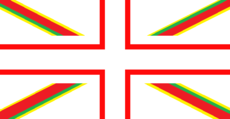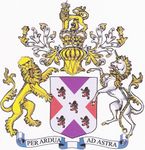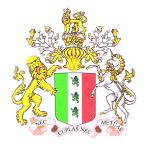National symbols of New Wessex
This article lists notable national symbols of the United Kingdom of New Wessex.
Flag
 |
|
| Use | National flag |
|---|---|
| Proportion | ~1:2 (40:77) |
| Adopted | 14 January 2012 |
| Design | The Cross of Saint Patrick modified with green and yellow lines, over all a hollowed-out Cross of Saint George. |
| Designed by | HR&IM King-Kaiser-Emperor Declan I, II & V |
The national flag of the United Kingdom of New Wessex, usually known simply as the Flag of New Wessex or the New[1] Wessaxon Flag, is the flag used to represent the country and its people. The current flag was designed by the King of New Wessex, Declan I.
The features displayed on the flag represent various national and cultual aspects of the Wessaxon people. It consists of the same hollowed-out St. George's Cross used in the flag of constituent country Wilcsland, edged in white, superimposed on a modified St. Patrick's Saltire. The former is used to represent Wilcsland, whereas the latter is used to represent the Irish heritage of the House of Mac Donnchadha-Houghton, the ruling dynasty of New Wessex. This gives the flag a similar look to that of the Union Flag, the British national flag, which also features a superimposition of the St. George's Cross and St. Patrick's Saltire. The St. Patrick's Saltire is modified by the addition of counterchanged lines of yellow and green - these represent the former Wessaxon possession Orly, as yellow and green are the only two colours found in both the flags of the Grove and Copan, the two states which comprise Orly.
Two variants on this design had been created and proposed before the current flag was chosen for official use:
Coat of arms
| Coat of Arms of the United Kingdom of New Wessex | |
|---|---|
 | |
| Details | |
| Armiger | The King of New Wessex; the King of Wilcsland; the House of Mac Donnchadha-Houghton |
| Adopted | 20 October 2012 |
| Crest | Heraldic Wessaxon Imperial crown |
| Escutcheon | Quaterly: 1 and 4 Gules a lion rampant Or armed and langued Azure, 2 and 3 Azure a harp Or stringed Argent. |
| Other elements | The shield is set in front of two crossed sceptres, the Wessaxon sceptre and a sceptre tipped with an enthroned monarch |
The coat of arms of New Wessex is the coat of arms used by Declan I, II & V in his official capacity as King of New Wessex and as King of its constituent country Wilcsland, and is used to represent the authority of the monarch. Unveiled on 20 October 2012, it was designed by Haakon Lindstrom and Declan I, II & V and adopted for official use later that day.
The shield in the centre of the coat of arms is quartered. The first and fourth quarters depict a golden rampant lion with blue tongue and claws on a red background: the lion is the national animal both of New Wessex and Wilcsland, but it also represents the British origins of New Wessex - the lion is depicted as golden on a red background as in the English coat of arms, but it is also depicted as a single rampant lion rather than three passant guardant lions, and has blue claws and tongue, as in the Scottish coat of arms. The second and third quarters depict a golden Cláirseach (Irish harp) with silver strings on a blue background - the coat of arms of Ireland. This represents the Irish heritage of the ruling dynasty of New Wessex, the House of Mac Donnchadha-Houghton.
The shield is set in front of royal ermine robes of red, white and gold, and bordered by a livery collar which hangs down from the robes. In front of the robes but behind the collar and shield are two crossed sceptres - one is the Wessaxon sceptre, and another is a golden sceptre tipped with an effigy of a seated monarch, itself holding a sceptre and a globus criciger. These two sceptres represent the power and the authority of the monarch. The coat of arms is topped by the Wessaxon Imperial crown as a crest.
The coat of arms was adopted in October 2012 - since the foundation of New Wessex in January earlier that year, the UKNW had used the coat of arms of Wilcsland which had been created in November 2011, but the new coat of arms replaced the earlier arms in Wilcsland too. They also replaced the previous coat of arms of the House of Mac Donnchadha-Houghton, which had been used since 2011.
-
The coat of arms of Wilcsland and its predecessor state Moylurg from February 2010 to November 2011.
-
The coat of arms of Wilcsland from November 2011 to October 2012, adopted as the arms of New Wessex in January 2012.
-
The coat of arms of the House of Mac Donnchadha-Houghton (then known as MacDonagh) from February 2010 to November 2011.
-
The coat of arms of the House of Mac Donnchadha-Houghton from November 2011 to October 2012.
Royal Standard
| Royal Standard of the United Kingdom of New Wessex | |
|---|---|
 | |
| Details | |
| Armiger | The King of New Wessex |
| Adopted | 20 October 2012 |
The Royal Standard of the United Kingdom of New Wessex is the heraldic banner used by the monarch of New Wessex in his capacity as such. Adopted on 20 October 2012 alongside the Wessaxon coat of arms, the Royal Standard is a rectangular banner divided into quadrants, of the same design as the shield in the coat of arms (a lion rampant in the first and third quadrants and an Irish harp in the second and third).
It has been proposed that other royals in the House of Mac Donnchadha-Houghton will be granted their own arms based on variants of the Royal Standard, as is similar to the arms of those related to the monarch in Austenasia and Britain.
Sceptre
The Wessaxon sceptre is a design for a sceptre often depicted in Wessaxon art and heraldry. It is most notably featured in the coat of arms of New Wessex, but has also been used in several portraits of monarchs since late 2010. The design is that of a golden sceptre tipped with a white model of a hand with the thumb, forefinger and middle finger pointing out and the other two fingers held flat against the palm. The hand represents the absolute power of the monarch.
Imperial crown
The Wessaxon Imperial crown is a design for a crown often depicted in Wessaxon art and heraldry. It is most notably featured in the coat of arms of New Wessex, but has also been used in several portraits of monarchs. The first known depiction of the Wessaxon Imperial crown was during the War of the Orlian Reunification in December 2010 - Declan I, II & V drew a self-portrait of himself wearing a crown with eight half-arches to hint that he would soon be holding the rank of Emperor. The crown in this portrait was depicted as very similar to the Imperial Crown of India, which likewise has eight half-arches to display a claim to Imperial rank.
The Imperial crown depicted in the coat of arms has a different design, however. Although it maintains the distinguishing eight half-arches, they are a lot higher, with no cap visible. The circlet is topped with cross pattées stylised in the shape of shamrocks, representing the Irish heritage of the House of Mac Donnchadha-Houghton. The Wessaxon Imperial crown in the coat of arms symbolised the personal union of New Wessex with the Empire of Austenasia, as well as the "imperial" power of New Wessex in its own right in the sense of its monarch's control over many wide-spread territories.
National animals
The lion is the national animal of New Wessex. The lion was the national animal of the Kingdom of the Taklamacan in 2005 - the Taklamacan merged into the Kingdom of Moylurg in March 2010, and Moylurg transitioned into the Wessaxon constituent country of Wilcsland in November later that year. The lion was adopted as the national animal of New Wessex due to previously having been the Wilcslandian national animal.
Notes
- ↑ While the demonym of the UKNW is simply "Wessaxon", this is sometimes lengthened to "New Wessaxon" when a distinction needs to be made from the heptarchtical Ango-Saxon kingdom of Wessex.
 |
General
Administrative regions
Wilcsland • Orly • Saqqara • New Wiltshire Former states
Monarchs
Declan I, II & V • Nectombetec I • Djoser I/A • Olcut I/A • Temecbo • Telecbo • Olcut II the Great • Olcut III/C • Djoser II/B • Tupo • Barry I • John I • Kieran I & I • Alexander I (usurper) • Joshua I • Other notable people
Locations and monuments
|





